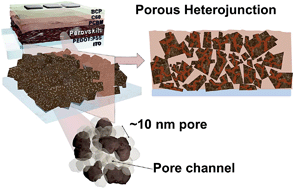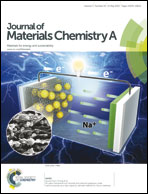Hierarchical i–p and i–n porous heterojunction in planar perovskite solar cells†
Abstract
A hierarchical pore network in planar CH3NH3PbI3 perovskite is demonstrated herein. Quantitative characterizations by grazing incidence small angle X-ray scattering (GISAXS) with modeling and complementary microscopic observations provide insight at various length scales. It is a pore structure comprised of nano-scaled primary pores aggregating into meso-scaled fractal networks within the perovskite layer. Its structural evolution and mechanistic interpretation are explored with respect to different preparation methods/steps. The time-of-flight secondary ion mass spectrometer (TOF-SIMS) results suggest the infiltration of hole transporting materials (HTM) or electron transporting materials (ETM) deposited on top at different length scales. The inter-penetrating perovskite/HTM or perovskite/ETM form i–p or i–n one-sided porous heterojunctions, respectively, over the typically regarded planar-stacked heterojunction. They show distinctive photovoltaic characteristics and behaviors in which the large i–n interfaces at the nanoscale lead to highly efficient, hysteresis-free and reliable solar cell devices. The morphology–performance correlation is helpful for associated design of device architecture and processing toward higher efficiency and stability.


 Please wait while we load your content...
Please wait while we load your content...